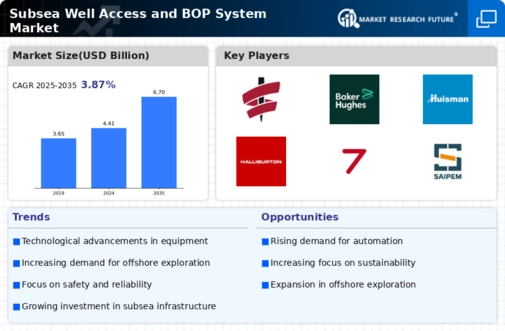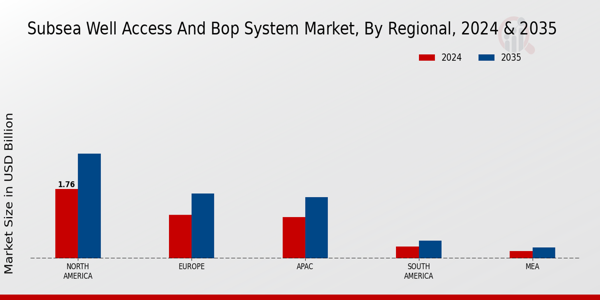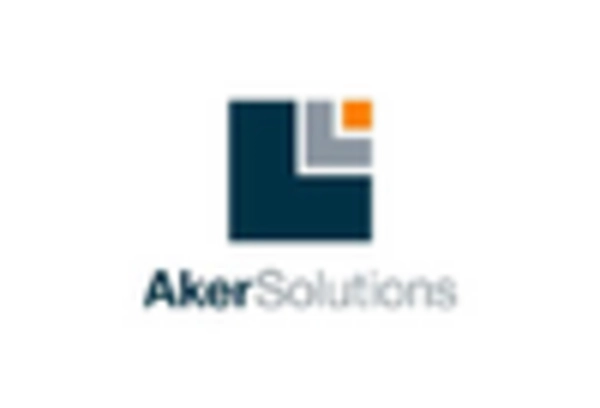Rising Energy Demand
Rising energy demand is a significant driver of growth in the Subsea Well Access and BOP System Market. As global energy consumption continues to escalate, particularly in emerging economies, the need for efficient oil and gas extraction methods becomes increasingly critical. Subsea resources are viewed as a vital component in meeting this demand, leading to heightened investment in subsea exploration and production. Recent projections indicate that global energy demand could increase by 25% by 2030, necessitating the development of advanced subsea well access and BOP systems to ensure safe and efficient extraction. This growing demand is likely to stimulate innovation and competition within the subsea market, as companies strive to enhance their operational capabilities.
Regulatory Compliance
Regulatory compliance is a crucial driver in the Subsea Well Access and BOP System Market. Governments and regulatory bodies are imposing stricter safety and environmental regulations to mitigate risks associated with subsea operations. Compliance with these regulations necessitates the adoption of advanced BOP systems that meet safety standards and operational guidelines. Companies that fail to adhere to these regulations may face substantial fines and operational delays. Market analysis indicates that the demand for compliant subsea well access and BOP systems is likely to increase as operators prioritize safety and regulatory adherence. This trend is expected to drive innovation and investment in the development of systems that not only meet but exceed regulatory requirements.
Sustainability Initiatives
Sustainability initiatives are becoming a driving force in the Subsea Well Access and BOP System Market. Companies are increasingly focusing on reducing their environmental footprint and adhering to stringent regulations. The push for cleaner energy sources and the reduction of greenhouse gas emissions are prompting operators to invest in more efficient subsea technologies. For instance, the development of eco-friendly BOP systems that minimize the risk of spills and leaks is gaining traction. Market data indicates that investments in sustainable technologies could account for up to 30% of total spending in the subsea sector by 2026. This shift towards sustainability not only aligns with The Subsea Well Access and BOP System.
Technological Advancements
The Subsea Well Access and BOP System Market is experiencing a surge in technological advancements that enhance operational efficiency and safety. Innovations such as remotely operated vehicles (ROVs) and advanced subsea control systems are becoming increasingly prevalent. These technologies facilitate real-time monitoring and control of subsea operations, thereby reducing the risk of accidents and improving response times. Furthermore, the integration of artificial intelligence and machine learning into subsea systems is expected to optimize drilling processes and maintenance schedules. According to recent data, the adoption of these technologies could potentially lead to a 20% reduction in operational costs, making subsea operations more economically viable. As a result, the industry is likely to witness a significant increase in demand for advanced subsea well access and BOP systems.
Increased Exploration Activities
The Subsea Well Access and BOP System Market is witnessing increased exploration activities, particularly in deepwater and ultra-deepwater regions. As oil and gas reserves in conventional fields become depleted, companies are compelled to explore more challenging environments. This trend is supported by advancements in drilling technologies that enable efficient extraction from previously inaccessible areas. Recent statistics suggest that deepwater exploration investments are projected to reach USD 200 billion by 2027, indicating a robust growth trajectory for the subsea well access and BOP system market. The need for reliable and efficient BOP systems is paramount in these operations, as they play a critical role in ensuring safety and operational success in high-pressure environments.


















Leave a Comment